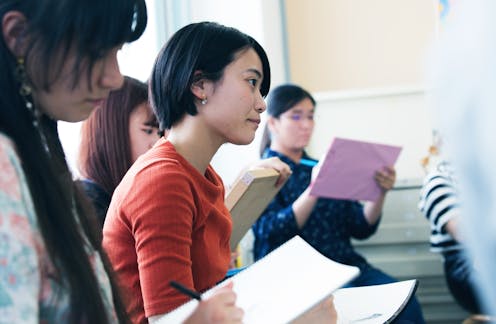
The Research Brief is a short take about interesting academic work.
The big idea
Experiencing discrimination significantly harmed the well-being of Asian and Asian American college students in the U.S. during the first wave of the COVID-19 pandemic.
That’s the key finding of our study, which compared over 6,000 survey responses from Asian and Asian American students who took the National College Health Assessment – an annual survey of student health behaviors – in the fall of 2019 and the fall of 2020. Our study focused on only on Asians and Asian Americans. Others have found that both Asian and Native American ethnic groups experienced the highest rates of COVID-19-related discrimination.
We found that Asian and Asian American students experienced high levels of stressors during the COVID-19 pandemic. By fall 2020, 9% had a loved one who had died from COVID-19, 7% reported experiencing discriminatory behavior because of the pandemic, and 61% had pandemic-related financial stress. Compared with 2019, Asian students in 2020 reported significantly more insomnia and psychological distress.
We then determined what factors most accounted for students’ poor mental health. We also tested whether the impact of these factors changed with the stressors of the pandemic.
In 2019, 11 factors were significant predictors of suicidality – that is, thoughts of suicide and attempts – in Asian students. Some of these factors are variables mental health professionals know to screen for: diagnosed depression, loneliness, and higher alcohol and drug use. But we found other significant predictors of suicidality – food insecurity, hours of screen time and experiencing discrimination – that are not often assessed in health settings. We also found variables that protected mental health. These included sleeping well, exercising and spending time with loved ones.
In 2020, only three factors were significant predictors of suicide – depression, loneliness and discrimination. The impact that experiencing discrimination had on suicidality also almost doubled, and there were no longer any significant protective factors.
Why it matters
We wanted to understand the experiences of Asian and Asian American students for two reasons. First, Asian college students are the racial group with the greatest unmet mental health need. Only 20% of Asian college students diagnosed with a mental health disorder receive treatment, compared with 40% of students overall.
Second, in 2020 there was a sharp increase in anti-Asian hate incidents. For example, the nonprofit Stop AAPI Hate, which tracks incidents of hate and discrimination against Asian Americans, saw a jump in reported incidents from about 3,800 annually before the pandemic to over 6,600 after the first year of the pandemic.
These incidents came at a time when former President Trump was associating COVID-19 with Asians by calling it “the China virus” or “kung flu.”
From 2016 to 2020, suicide was the leading cause of death among Asian adolescents. To reduce deaths from suicide, researchers must first understand what individual factors increase or decrease its likelihood.
Our research shows that experiencing loneliness and discrimination significantly harmed Asian students’ mental health. This finding is true in typical years, such as 2019, but especially in times of acute social turmoil.
These findings provide insight on how universities and health care providers can better support students’ mental health by addressing the psychological impact of experiencing racism.
What’s next
Now that researchers better understand what predicts psychological distress in Asian American students, the next steps are to apply this information. Future research is needed to understand better how therapy that supports healing from racial discrimination could support students’ mental health.
Research should also evaluate how treatments aimed at improving sleep quality could support Asian students’ mental health. These interventions could improve mental health especially in times of social turmoil.
Roxanne Prichard receives funding from the National Science Foundation and Howard Hughes Medical Institute.
This article was originally published on The Conversation. Read the original article.







